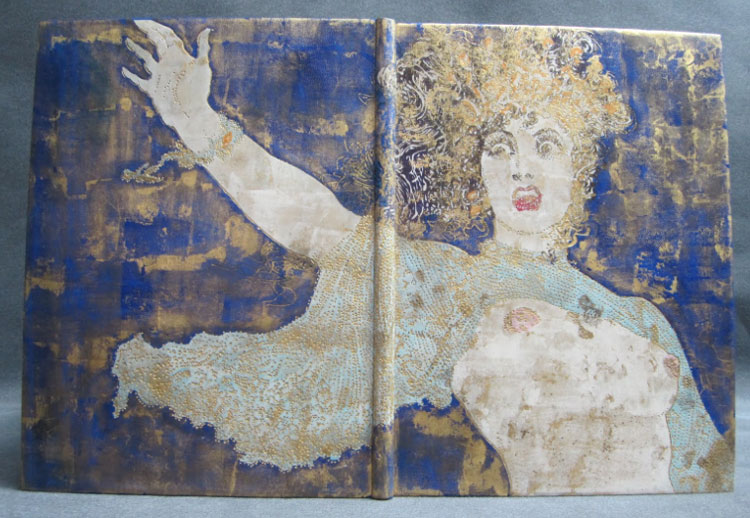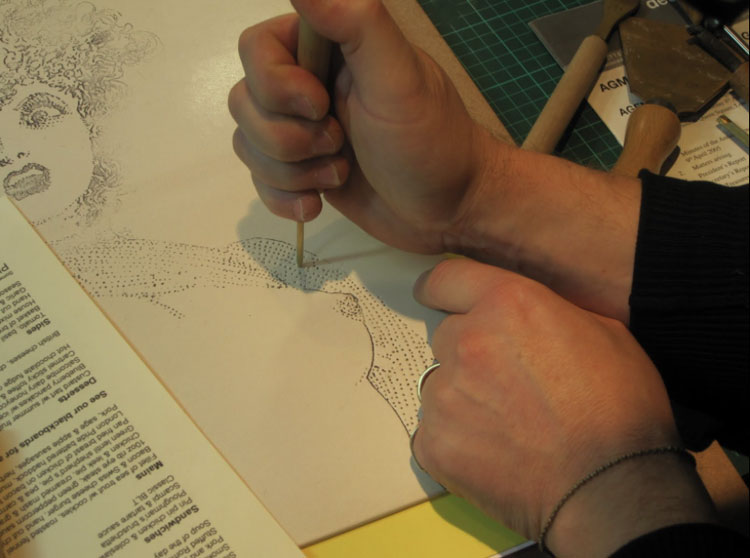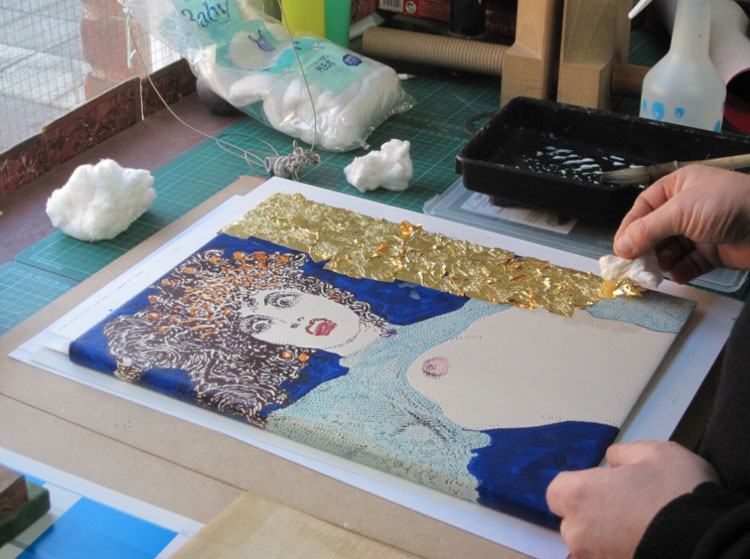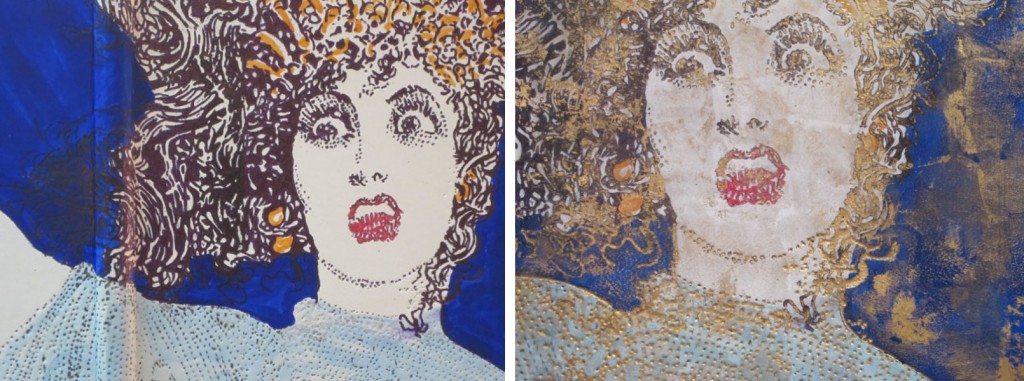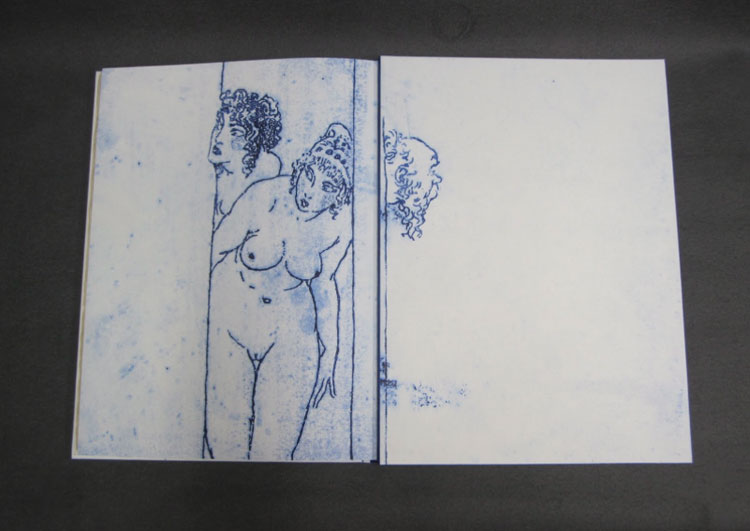Bound in 2010, this is just one binding of Lysistrata that Mark Cockram has bound. Grabbing illustrations from the text for both the cover design, doublures and endpapers; Mark transforms them into a visual experience rarely seen on a book. The cover mimics that of a fresco painting.
The book was bound in fair goat which was hand-dyed and the design was initially blind tooled onto the leather. Mark handcrafted 7 new tools for the book, which were modified throughout the tooling process. He discusses his technique more in depth below.
This binding is by far my most favorite from your portfolio. There are so many artistic details I find to be rather captivating. I wanted to ask you about your technique for distressing the gold leaf?
My glib answer would be to say that shouting at gold leaf usually distresses it, though I feel that is not the answer you were looking for.
Though gold leaf and other metals are used in bookbinding, gold leaf and the like tend to be used in a static manner. By static manner I refer to the traditional way in which it is applied to books. Please forgive me if I do not elaborate on finishing/tooling with gold leaf, there are many books, workshops and bits and bobs on the Internet for those who wish to find out more. There is so much more to the application of gold leaf than traditional gold tooling or finishing, one only has to look outside of bookbinding to realise that.There is great skill in finishing, indeed, the training for a finisher is usually longer than for a forwarder, with the finisher being paid more. What has always made me smile is the way the layman is always amazed with the gold tooling, but fails to see the book. If it were not for the forwarder there would be nothing for the finisher to do except, perhaps, wall panels and the like. This brings to mind one lecture and one question in particular. I was asked by a very earnest student what I thought of fine binding? I asked her to tell me what a ‘fine binding’ was. Her reply was the usual ” Well, it is full leather with gold tooling …….. of course.” After a considered pause I told her that I had seen many full leather bindings with lashings of gold tooling and that in no way would I call them fine. Any book beautifully made, balance of materials, fit for purpose, harmony of craft and art is a fine binding in my eyes. I cannot remember her response, but I do remember her looking over to a small group of people, arms folded, scowls and mumbling between themselves, whom I can only assume were her teachers. I only hope that the student began to ask questions and open not only her eyes, but ears also.I suppose that like many people, bookbinders and collectors like things to be classified to make them easy to understand. Just as a point, if one were to ask what is fine art? Would the answer be oil paint on canvas? I, of course, doubt that to be any answer that any serious artist or those appreciating the arts would give. So why is it that so many contemporary bookbinders and collectors, curators and so on appear to have the pre-impressionist salon approach to what fine binding is? To carry this forward we could argue that though both the salon artists (the establishment) and the Impressionists (non establishment) used the same materials, it was the application of the materials and the way the artists saw their work that was different. One challenged the preconceptions of what is and painted what they felt and saw, the other hid behind technique and history (I realise this is a somewhat simplified view, but I hope you get my drift). I always have half an eye on technique and history, but I will not let them get in the way or limit what I want to produce. Please do not assume that I consider myself to be in any way akin to the Impressionists, I only use them to make a point.
With the 2010 Lysistrata I wanted to echo the illustrations in the text block. One method commonly used is to copy an illustration, have a block made and use that to do the tooling with. Another method is to transfer the image to thin paper, blind tool through that and then tool in the usual way. However, I feel that the line is static, it has no life. I know that by putting the tool down at an angle the reflected light creates an impression of movement, but there is still that feeling of it being contrived. I suppose I am of the ilk that think if you want something to look like a splash of paint then splash with paint, there is no need to spend hours, days in trying to get gold tooling to look like a spontaneous splash of paint. Are we meant to admire the technique ? That it looks so much like a spontaneous (even though it is not) splash of paint or do we admire the spontaneity of the person who is able to splash the binding with paint? The paint being an intrinsic element of the book as opposed to an applied decoration. Is this a case of seeing the technique and not seeing the book? Perhaps people find it easier to admire technique as that is quantifiable and can be tweaked, whereas the spontaneous is less quantifiable and in no way can be tweaked. The spontaneous it is less safe and one has to live with the result, in other words it is alive.
I do not think that I have to say that in some of my work I am spontaneous with the 2010 Lysistrata captureing some of that working style. The leather was hand dyed off and on the book. The black line and cold gold work is loose, it is the sketch like quality of the line that creates the tension and that all so elusive movement. The gold is adhered (please do not ask me what adhesive I use, a boy has to have a secret or you could come to a workshop) to the binding after the black line work with the tooling done with a number of warmish hand tools. The gold is further worked with 000 grade, oil free, wire wool. I wanted the finished work to resemble a wall painting or fresco, I think I am somewhere near the mark. The work was a commission and I kept the client informed of progress, he would pop into the studio and watch me work. He delighted in the non formulaic approach, so far from the rest of his collection. I prefer to work with collectors that give me and the book space to breath, to expand and explore what is or maybe possible and not to rely on what has been.
